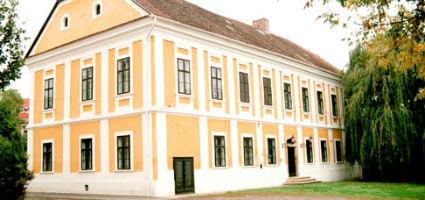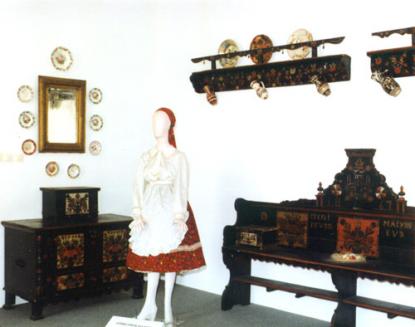2024. November 23. Saturday
Regional Museum of Völgység - Bonyhád
 |
Address: 7150, Bonyhád Szabadság tér 2.
Phone number: (74) 451-342, (74) 550-053
E-mail: vmbony@tolna.net
Opening hours: 01.01-31.03, 01.10-31.12.: Tue-Fri 10-16
01.04-30.09.: Tue-Sat 10-16 |
Museum tickets, service costs:
|
Ticket for adults
|
400 HUF
|
|
|
Ticket for students
|
200 HUF
|
|
|
Ticket for pensioners
|
200 HUF
|
|
|
Guide
(in Hungarian, German and English)
|
4000 HUF
|
|
|
Audio guide
(in Hungarian, German, Russian)
|
500 HUF
|
The Völgység is situated in the Trans-Danubian Hills, to the North of the Mecsek mountain. Its centre is in the Bonyhád valley.

At the beginning of the 18th century only a few Serbs and Hungarians inhabited in the region. However, in the middle of the century German and Jewish settlers were coming to this territory.
The agriculture got stabilized in the 18th century, and the workers of the Völgység were joining to newly organized guilds. Bythe end of the century Bonyhád became one of the commercial junctions of Southern Trans-Danubia.
In the reform era the Völgység also became a literary land. Our great romantic poet, Mihály Vörösmarty had served as a trainer for the famous Percel brothers. The beauty of the land, the friendship with Antal Egyed and László Teslér, and the love affair with Etelka Perczel were determining factors in the life of the young poet.
After the liberation of the bondslaves (1848) the animal husbandry took the place of the tobacco growing. It was this when the special Bonyhád kind of cattle was first breeded.
From the 19th century on the competition of the Austrian and Czech factories was slowly destroying the conventional regional small industry, which - regardless of the doing away with the guild system in 1872 - was still functioning at the time of the first world war. However, in the first part of the 20th century two significant manufactories were established in Bonyhádon: the enamel factory and the Shoe factory.
The exhibition also represents the etnography of the region. We can learn about the tragedy (of 1944) of the Jewish people living in Bonyhád, which redulted in the resettling of some part of the German population. We can also follow up the history of the Bukovinan people and their continuous flee through Bukovina and Bácska, and their final settlement (1945) in the villages of the Völgység. At the same time poor peasants of the Hungarian Plains, Transsylvanian and other Hungarian refugees were moving to this region.

At the beginning of the 18th century only a few Serbs and Hungarians inhabited in the region. However, in the middle of the century German and Jewish settlers were coming to this territory.
The agriculture got stabilized in the 18th century, and the workers of the Völgység were joining to newly organized guilds. Bythe end of the century Bonyhád became one of the commercial junctions of Southern Trans-Danubia.
In the reform era the Völgység also became a literary land. Our great romantic poet, Mihály Vörösmarty had served as a trainer for the famous Percel brothers. The beauty of the land, the friendship with Antal Egyed and László Teslér, and the love affair with Etelka Perczel were determining factors in the life of the young poet.
After the liberation of the bondslaves (1848) the animal husbandry took the place of the tobacco growing. It was this when the special Bonyhád kind of cattle was first breeded.
From the 19th century on the competition of the Austrian and Czech factories was slowly destroying the conventional regional small industry, which - regardless of the doing away with the guild system in 1872 - was still functioning at the time of the first world war. However, in the first part of the 20th century two significant manufactories were established in Bonyhádon: the enamel factory and the Shoe factory.
The exhibition also represents the etnography of the region. We can learn about the tragedy (of 1944) of the Jewish people living in Bonyhád, which redulted in the resettling of some part of the German population. We can also follow up the history of the Bukovinan people and their continuous flee through Bukovina and Bácska, and their final settlement (1945) in the villages of the Völgység. At the same time poor peasants of the Hungarian Plains, Transsylvanian and other Hungarian refugees were moving to this region.
